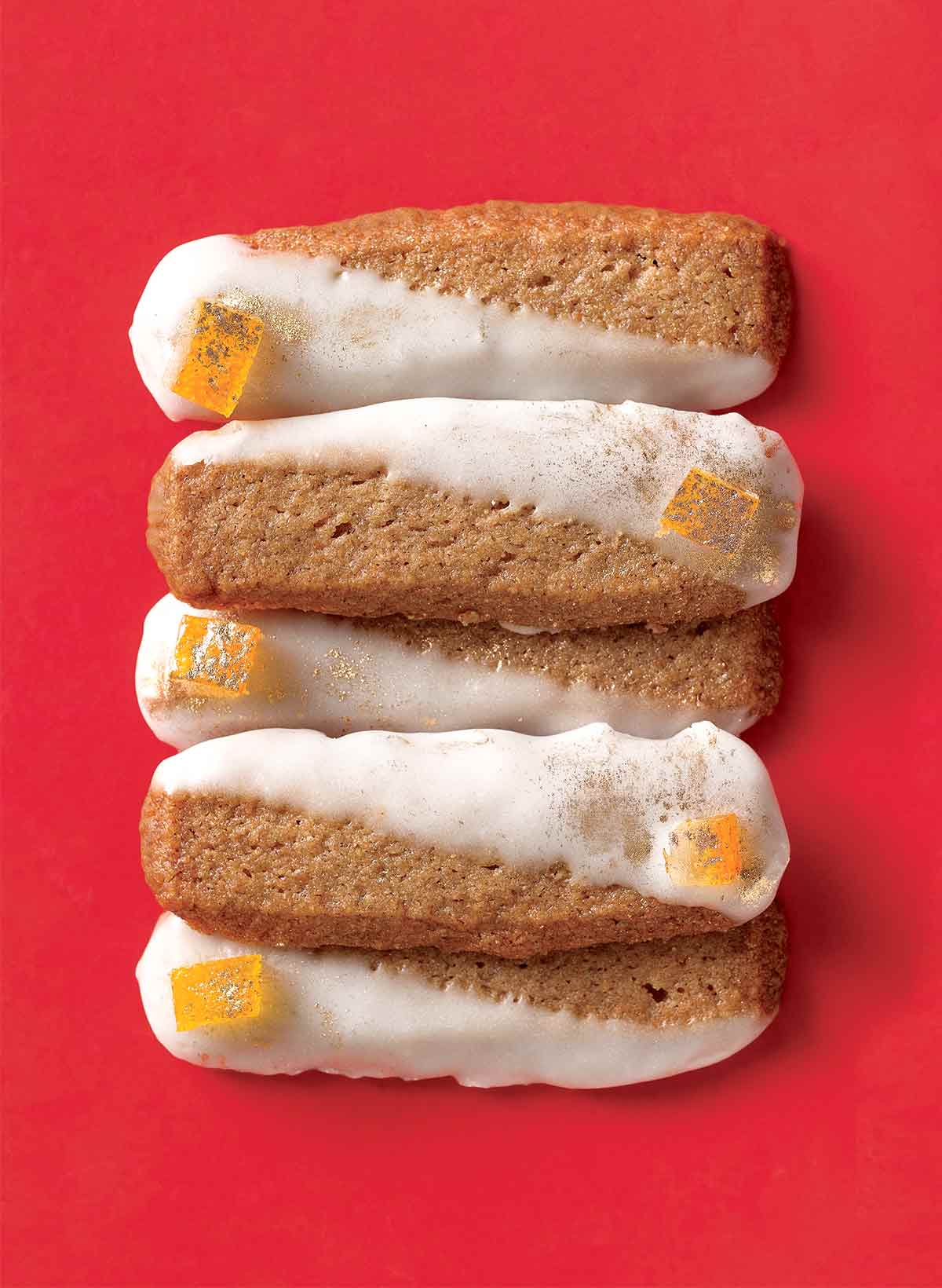
TL;DR (Quick-Answer Box)
- What it is: A French rye-flour cookie infused with warm spices, topped with a lemon-Grand Marnier glaze.
- Why you’ll love it: Their subtle sweetness and chewy texture make them an elegant alternative to gingerbread, perfect for holiday parties.
- How to make it: Cream butter, sugars, honey + vanilla, then mix in flours + spices. Roll out the dough and chill overnight. Cut into small rectangles, transfer to a baking sheet, chill until firm + bake until the edges darken. Glaze, garnish with candied orange peel, brush with optional luster dust.
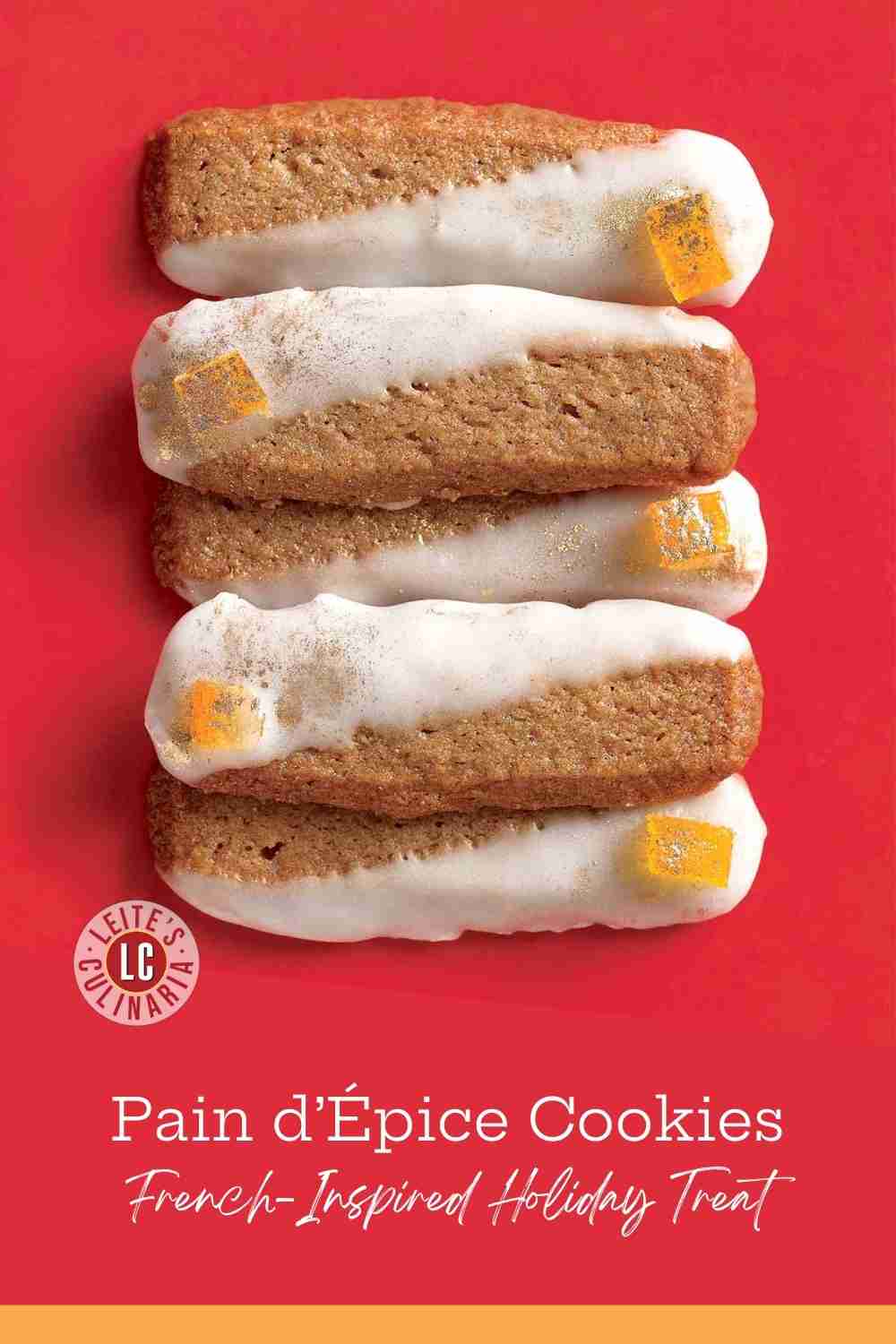
Jump To
Allspice, ginger, cinnamon, and nutmeg are familiar flavors. But when combined with honey and rye flour, they give cookies the depth and allure of pain d’épices, the Christmas bread of Dijon, France. An easy Grand Marnier glaze adds a sweet veneer and is practical as well, helping a garnish of candied orange peel to adhere.
Want to save this?
More Zingy Spiced Cookie Recipes
Spiced Rye Ginger Cookies
35 mins
Chinese Five-Spice Cookies
1 hr 40 mins
Pumpkin Spice Cookies
1 hr 40 mins
Write a Review
If you make this recipe, or any dish on LC, consider leaving a review, a star rating, and your best photo in the comments below. I love hearing from you.–David
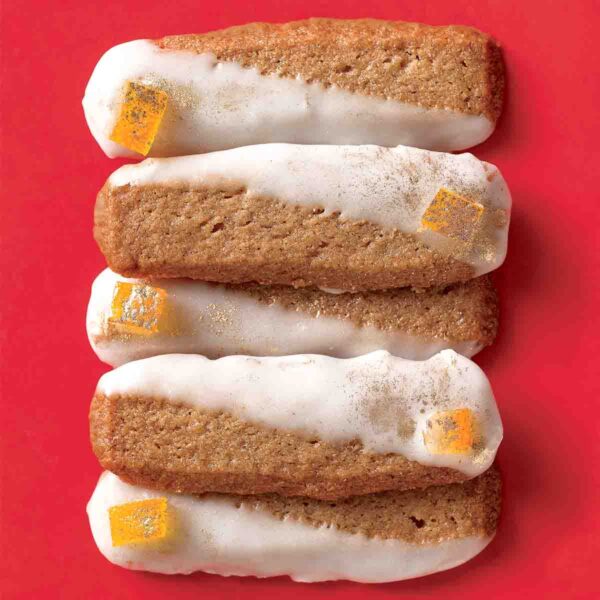
Pain d’Épice Cookies
Equipment
Ingredients
For the cookies
- 1 cup rye flour
- 3/4 cup all-purpose flour
- 1 teaspoon ground allspice
- 1 teaspoon ground ginger
- 3/4 teaspoon ground cinnamon
- 3/4 teaspoon grated or ground nutmeg
- 3/4 teaspoon salt
- 2 sticks unsalted butter, softened
- 1/4 cup granulated sugar
- 1/4 cup packed dark brown sugar
- 1 tablespoon mild honey
- 1 teaspoon vanilla extract
For the glaze
- 4 cups confectioners’ sugar, sifted
- 1 tablespoon Grand Marnier
- 1/4 cup whole milk
- 4 teaspoons fresh lemon juice
For the decoration
- Candied Orange Peel, cut into 1/4-inch dice
- gold luster dust
Instructions
Make the pain d’ épice cookies
- Whisk together the 1 cup rye flour, 3/4 cup all-purpose flour, 1 teaspoon ground allspice, 1 teaspoon ground ginger, 3/4 teaspoon ground cinnamon, 3/4 teaspoon grated or ground nutmeg, and 3/4 teaspoon salt.
- In a separate bowl, beat together the 2 sticks unsalted butter, 1/4 cup granulated sugar, 1/4 cup packed dark brown sugar, 1 tablespoon mild honey, and 1 teaspoon vanilla extract with an electric mixer at medium-high speed until creamy, about 1 minute. Reduce the speed to low and mix in the flour mixture until just combined. The dough will be sticky.
- Roll out the dough between 2 sheets of parchment paper into a 10-inch square (about 1/4 inch thick) or place the dough in a large resealable plastic bag (not one with a pleated bottom) and smooth the dough with a rolling pin, filling the bag with the dough.
- Place the dough (still on the parchment or in the bag) on a baking sheet and refrigerate for 8 to 12 hours to allow the flavors to develop.
- Preheat the oven to 350°F (176° C), adjust the oven rack to the middle position.
- Remove the top layer of parchment or remove the dough from the bag. Trim the ragged edges of the dough. Cut twenty 1/2-inch-wide strips with a pastry cutter and a ruler. Cut each strip crosswise into fourths for a total of 80 cookies. If the dough begins to soften, refrigerate or freeze it until firm.
- Transfer about 30 cookies to an ungreased baking sheet with a spatula, arranging them 1 inch apart. Keep the unbaked cookies in the refrigerator or freezer. If the cookies on the sheet are no longer cold, chill or freeze until firm. Bake until the edges are several shades darker, 13 to 15 minutes. Cool the cookies on the baking sheet for 1 minute, then transfer to a wire rack to cool completely. Repeat with the remaining cookies.
Make the glaze
- Whisk together the 4 cups confectioners’ sugar, 1 tablespoon Grand Marnier, 1/4 cup whole milk, and 4 teaspoons fresh lemon juice until smooth.
Decorate the pain d’épice cookies
- Tip the bowl of glaze on its side so the glaze is as deep as possible. Place a folded kitchen towel under the bowl for support. Dip half of a cookie into the glaze on a diagonal, letting any excess glaze drip off into the bowl and then scraping the bottom of the cookie on the edge of the bowl to remove any last extra drops of glaze.
- Set the cookie on a rack set over a baking sheet and immediately place a piece of candied orange peel on the glazed half of the cookie. Repeat with the remaining cookies, glaze, and Candied Orange Peel. Brush with gold luster dust, if desired.
- Let the cookies stand until completely set, about 1 hour. The cookies keep, layered between sheets of parchment paper in metal tins, at room temperature for up to 3 days.
Explore More with AI
Nutrition
Nutrition information is automatically calculated, so should only be used as an approximation.
Recipe Testers’ Reviews
These cookies were delicious, pretty, and, perhaps apart from making the candied orange peel, relatively quick and easy. My coworkers always welcome pastry, but these cookies were especially well received.
The dough came together easily and, after chilling, resembled a sweet compound butter. The dough seemed just a bit too thick for my fluted pastry wheel, so after a few strips, I switched to a knife. The glazing process was totally unfussy, and the orange peel cubes stuck perfectly.
One note: Cut the cookies as evenly as possible. It makes a noticeable difference in their size, once baked. The only possible downside I could see in these is that they are too delicate to mail in holiday cookie boxes, so they’ll have to stay local!
These cookies are very tasty indeed! The spice combination is delicious. I love the method of putting the dough in a one-gallon resealable bag and smoothing it out with the rolling pin. The dough was so even, I’ll try this technique with other cookie recipes.
You have to work fast with the dough once it comes out of the fridge, though, as it softens up at room temperature (just return it to the fridge for a few minutes and it will be fine). Each cookie came out looking exactly the same as the others.
The flavor of the Grand Marnier in the glaze is very subtle but goes nicely with the spiciness of the cookies. The candied orange peel recipe is delicious as well. You just have to cut the slices into smaller pieces to fit on the cookie. The extra peel is delicious dipped in melted chocolate! I didn’t have gold luster dust, but I will definitely look for it, as I’m sure it would add that extra something to the look of the cookies for the holidays. Will definitely make these again.
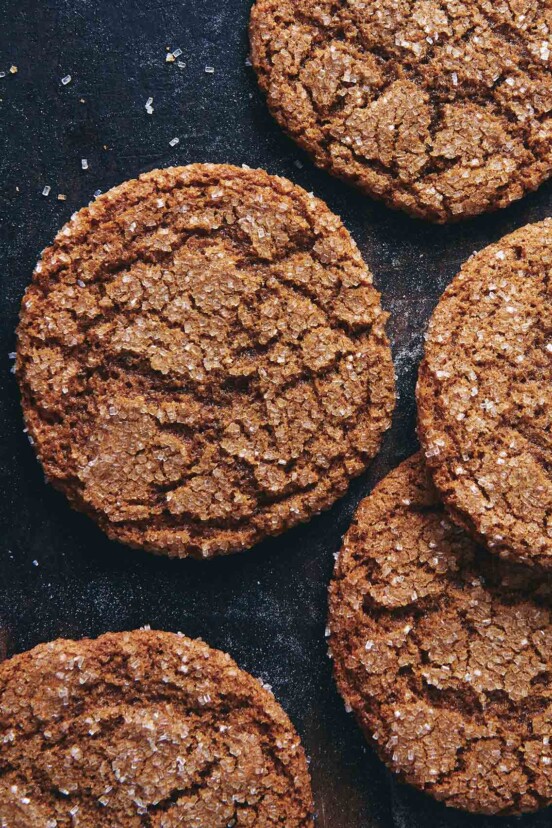
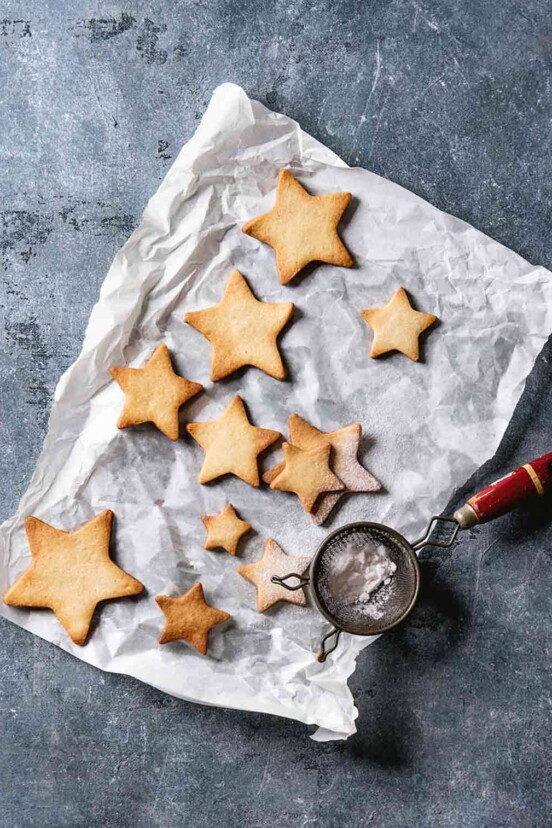
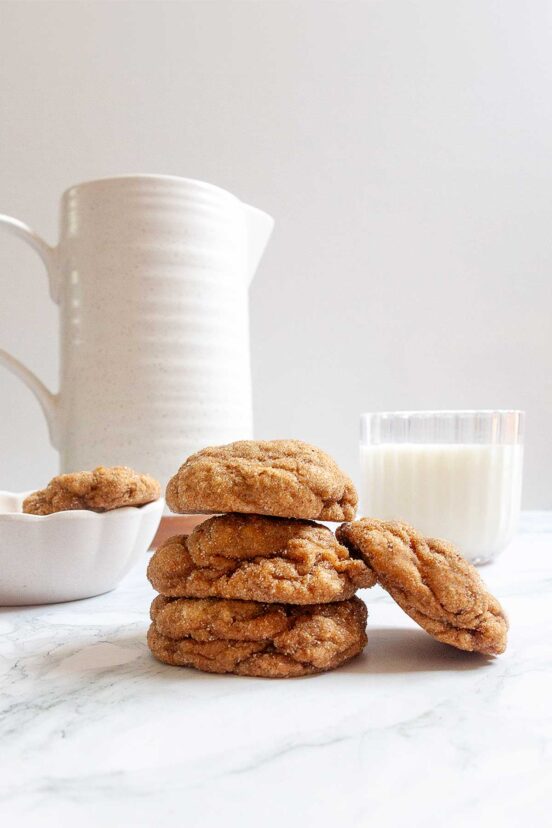
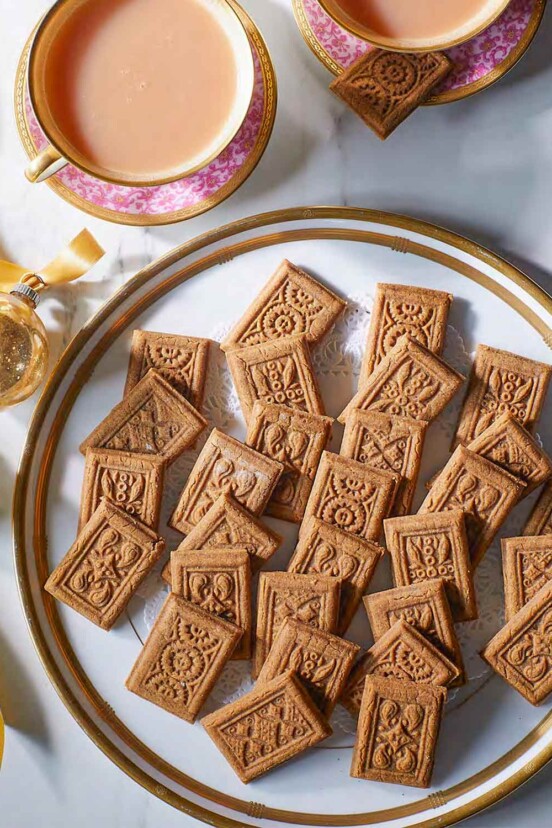










What is the light brown ‘dust’ on the pictured cookies? Looks like “luster dust” or maybe ground nutmeg or coriander to my eye. Did you leave it out of the recipe by accident, or did you decide the recipe is better without?
Thanks.
Hello, Jozie. It’s luster dust, but the original recipe didn’t call for it. It’s a whim of the food stylist. But, it does look lovely. If you use it, do let me know how it turns out.
Might I be able to freeze these unbaked for a few days? Trying to efficiently cram as much holiday baking as possible into a short window!
Kit, yes, you can absolutely freeze the unbaked cookies. Make the dough, cut them into strips, and freeze them on a baking sheet. From there, you can keep them in a resealable plastic bag or container and bake them directly from frozen. You may need to add a couple of extra minutes to the baking time.
These are delicious! I wonder if there is a variation on commercial powdered sugar, because glaze was too thick, even after adding another 1/4 c of milk. My gut also told me maybe I could make 1/2 recipe of glaze, and I should’ve listened. Nonetheless, lovely recipe!!
Thanks, Ann. I’m so glad you enjoyed them. I find the consistency of glaze can vary from bag to bag of confectioners’ sugar or even be impacted by the humidity outside.